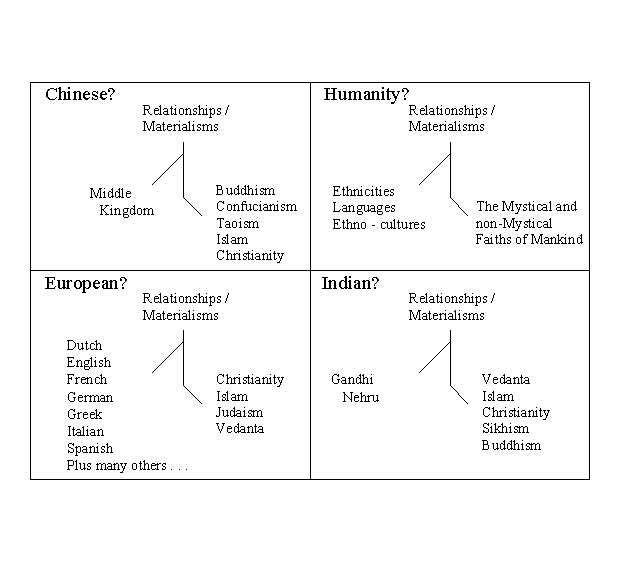China's Qin Terracotta Army
- the chinese clay warriors - pictures - images
The weather was very dry in 1974, and the grain was dying in the fields in Lintong county, Shaanxi province, near Xian,
China, and some local farmers decided to try to establish a new water well by digging at a low point in the terrain.
They encountered very hard red earth about a meter down and then, on the third day, they dug out something resembling a jar
whch one of the villagers wanted to take home to use as a container.
They also recovered a clay torso which was "like a statue in a temple".
In time the torso was to become established as having been the body of one of an actual army of terracotta clay warriors and the 'jar' to
have been the head of one of these clay warriors.
The farmers in this area had routinely come across terracotta clay fragments as they worked their fields and had sold many bronze
arrowheads they also discovered to the recycling station.
Some time later a Lintong county official responsible for cultural relics learnt that a large number of terracotta fragments had been found and rushed to the site
and asked the farmers to collect the fragments of heads, torsos, arms and legs they had recovered and pile them into three trucks, before taking them to Lintong Museum
and attempting to reconstruct the fragments into their original statues.
It wasn't until archaeologists arrived months later it was realized that the farmers had stumbled upon an
astonishing find in the form of large-scale terracotta warriors buried in the ground in which they had been digging.
The authorities were called in and subsequent investigations over a number of years have yielded up a terracotta clay army of figures depicting
warriors, archers and calvalry men together with a number of horse-drawn chariots and some figures
which were believed to depict persons of officer rank.
The chinese terracotta army has been dated to around 210 B.C. and is believed to have been created by the first
Emperor of a unified China - Qin Shi Huang.
The words Shi Huang translate as - First Emperor - so this individual is also known as the first Emperor
of the Qin dynasty. Chinese civilization has its roots in Shaanxi and Henan provinces where the Huang He, or Yellow River,
winds its way through its fertile valleys. The Han Chinese settled this area in the 3rd century BC. Xi'an, the capital of Shaanxi Province,
lies just a few miles to the west of where the Wei and Huang He converge.
Location map of Xian China where the
Museum of Terracotta Warriors and Horses is located
Qin, who died in 210 BC at the age of 50, created China's first unified state by conquering seven rival kingdoms. He built an extensive system of roads
and canals along with an early incarnation of the Great Wall of China. He introduced standard measurements, a single written language, currency and law.
Prior to the drought-stricken farmer's discoveries of 1974 the underground presence of the Terracotta Army was totally unknown.
The subsequent investigations of what was becoming appreciated as being an archaeological find of the first importance has allowed
a body of insights to be built up towards the understanding of the costumes, armaments, technology and societal organisation an entire,
and historically significant, human culture.
The first Qin Emperor, after forcibly incorporating other historically warring territories under his own rule eventually
bequeathed "China" to posterity.
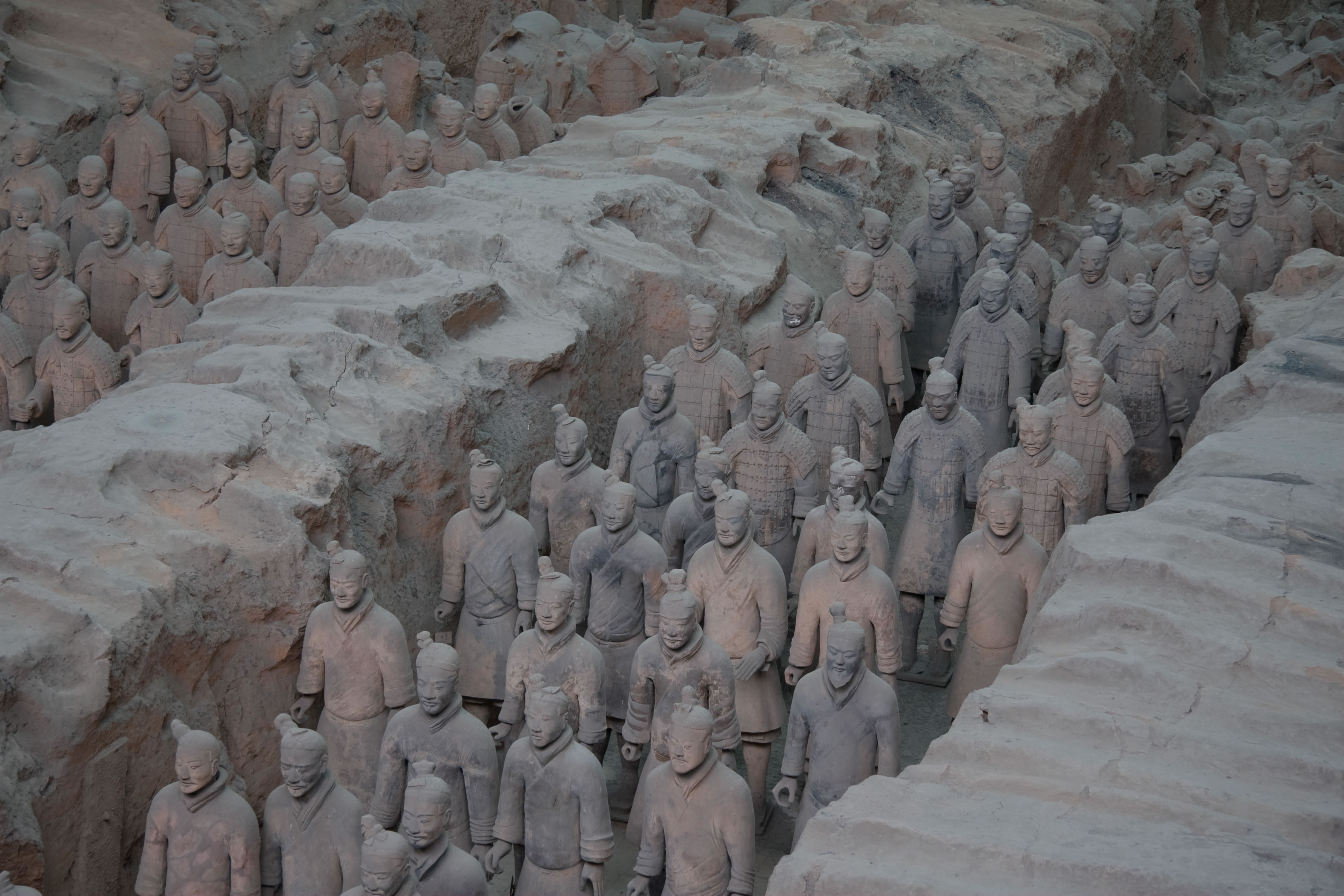
As these images and pictures show the terracotta warriors were buried in place in their ranks in several long pits
close to the tomb of the first emperor - possibly as guards and as aides for a future after-life.
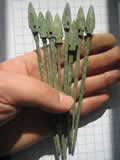 The swords, lances, halberds and crossbows entombed with the Terracotta Army are believed to have been new, and fully functional
as military equipment when buried. Blades show evidence of having been sharpened on a sort of rotary lathe or spinning whetstone. The
forty thousand heads of crossbow bolts, or arrows, have been analysed revealing hard, and penetrating, "heads" of a bronze alloy
containing some 20% tin to having been cast onto relatively flexible "tangs" which were some 3% tin, 1% lead and 96% copper. The swords, lances, halberds and crossbows entombed with the Terracotta Army are believed to have been new, and fully functional
as military equipment when buried. Blades show evidence of having been sharpened on a sort of rotary lathe or spinning whetstone. The
forty thousand heads of crossbow bolts, or arrows, have been analysed revealing hard, and penetrating, "heads" of a bronze alloy
containing some 20% tin to having been cast onto relatively flexible "tangs" which were some 3% tin, 1% lead and 96% copper.
The composite heads could then be mounted within slim wooden shafts, forming quite lethal bolts or arrows.
(Credit: Martinón-Torres, M, Li, X.J., Bevan, A, Xia, Y, Kun, Z and Rehren, T 2011. Making Weapons for the Terracotta Army.
Archaeology International 13:65-75, DOI: http://dx.doi.org/10.5334/ai.1316)
Some of these martial artefacts feature a marked degree of good preservation despite having been underground, and in contact
with soils, moisture, etc., for some 2,200 years. This high degree of preservation is in many cases due to the presence of a thin coating
of Chromium Oxide demonstrating that the Terracotta Army's armourers utilised chromium plating technologies that were not subsequently
equalled for more than two thousand years.

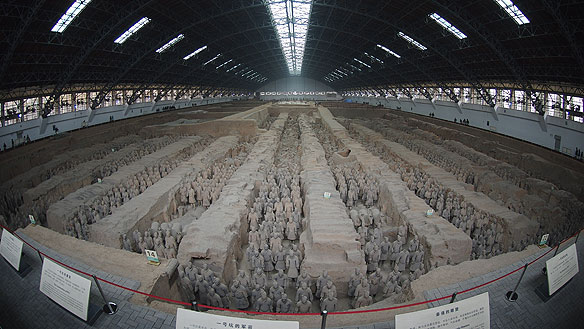
It has been estimated that perhaps, 700,000 people were involved in the construction
of an imperial tomb or mausoleum with an associated necropolis (i.e. city of the dead) and its accompanying
army of terracotta warriors.
The bodies and limbs of the terracotta warriors were seemingly originally cast, as wet clay, into moulds before being processed
into long-lasting
fired clay. Slight adjustments having been made to the original clay moulding allowing for the depiction of
a range of physical characteristics and bodily attitudes.
The heads, faces, ears, facial hair, hairstyles and head-wear of each member of the Terracotta Army are, however, fashioned such as to
give the appearance of an assembly of individuals.
The terracotta figures of warriors and horses, each of which tends to vary in height, uniform, and hairstyle
in accordance with rank, are arranged in the battle formations accepted by the Qin Emperor.

The recovered artefacts suggest that crossbowmen were significantly present in the ranks before and behind the charioteers and also
within the two flanking files where their actions could help to deter approaching rivals.
(Credit: Martinón-Torres, M, Li, X.J., Bevan, A, Xia, Y, Kun, Z and Rehren, T 2011. Making Weapons for the Terracotta Army.
Archaeology International 13:65-75, DOI: http://dx.doi.org/10.5334/ai.1316)
To date four major, and several hundred lesser, underground pits, totaling 22,000 square meters, have been discovered with an estimated 8,000
life-size terracotta figures of warriors together with 130 chariots with 520 horses and 150 cavalry horses.
Some of the terracotta warriors have no been found with no beards, but for ancient Chinese, facial hair was part of the culture, so
those warriors could be considered to represent soldiers under 17 years old.
At between five feet eight inches and six and a half feet (or two metres) tall,
the human statues weigh between three and four hundred pounds (or one hundred and eighty kilos).
There are also some terracotta figures of actors, performers and civilian officials as well as ancient armour from the Qin Dynasty that were made in some of the smaller pits,
The terracotta actors are depicted mostly half-naked, wearing skirts of ancient court performers hired to amuse the emperor and officials. Each terracotta actor is in a different pose
to show the variety of court entertainment.

The Qin Emperor's Mausoleum Complex is laid out on a large scale with the pits housing the Terracotta Army actually being located
between the Imperial Tomb and the homelands of the most formidable of the subject peoples the Qin Emperor's armies had subdued.
(Credit: Martinón-Torres, M, Li, X.J., Bevan, A, Xia, Y, Kun, Z and Rehren, T 2011. Making Weapons for the Terracotta Army.
Archaeology International 13:65-75, DOI: http://dx.doi.org/10.5334/ai.1316)
Each of the major pits lies 15 to 20 feet (5-7 Meters)
below current ground level and was constructed with the figures placed in
corridors or rooms. These corridors, separated by earthen walls, are paved with pottery bricks on which the warriors and horses
stand. Large wooden planks placed over the corridors between the earthen walls and covered by layers of mats made from
reed fibres formed the roofing. This was then covered by earth to conceal the the army's location.
The Qin Imperial burial ground itself exhibits a
80-metre-high earth pyramid standing on top of a burial chamber but this is located at the center of a giant necropolis, or city of the dead,
spread over 2.13 sq km with an inner underground
palace surrounded by an outer city.
The outside walls of the
tomb complex are as if placed there to protect the tomb from the east, where all the conquered states lay. They are solidly built
with rammed earth walls
and ground layers as hard as concrete.
The four seven-meter-deep principal pits associated with the dig are about 1.5 km east of the Qin Imperial burial ground.
Pit one, (the largest at 230 meters long, first opened to the public in 1979), which contains the main army, has 11 corridors, most of which are over 3
meters wide, and paved with small bricks with a wooden ceiling supported by large beams and posts. This design was also used for the
tombs of noblemen
and would have resembled palace hallways. The wooden ceilings were covered with reed mats and layers of clay for waterproofing,
and then mounded
with more soil making them, when built, about 2 to 3 meters higher than ground level.
Pit two (found in 1976 and unveiled to the public in 1994), housed cavalry and infantry units as well as
war chariots, and is thought to represent a military guard. Pit three (found in 1976 and on display in 1989) is the command post, with high ranking
officers and a war chariot.
A fourth pit is empty, seemingly having been left unfinished by its builders.
In the 2,000 years since the construction of the pits the roofing collapsed damaging the figures.
The first excavation of the site lasted six years betweeen 1978 and 1984, during which some 1,087 clay soldiers were discovered.
A second excavation started in 1985 but was cut short after a year.
The Museum of Terracotta Warriors and Horses in Lintong county, some 35 km from central Xi'an,
has received about 70 million visitors, including at least 7 million from abroad since opening to the public in 1979.
The terracotta clay army is one of the greatest archaeological finds of modern times and forms the centrepiece of a major
archaeological discovery location that was
listed as an UNESCO World Heritage Site in 1987.
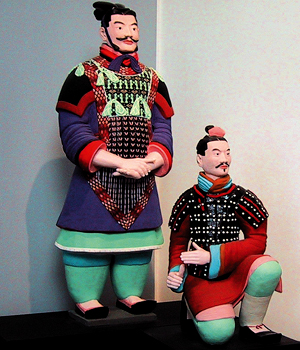 In 2009 archaeologists resumed fairly large-scale investigations into the
terracotta warriors in the hope that
more recent technological advances would allow a greater insight to be obtained into the original pigmentation
applied to the individual members of the terracotta army when they were originally made. In 2009 archaeologists resumed fairly large-scale investigations into the
terracotta warriors in the hope that
more recent technological advances would allow a greater insight to be obtained into the original pigmentation
applied to the individual members of the terracotta army when they were originally made.
In past excavations, clay figures bearing traces of rich colour were unearthed but once they were exposed to the air the colours began to
lose their definition and turned into an oxidized grey.
One archaeologist working on site said, "there is colour here, in the pupil and on this part of the cheek and on the
forehead you can see the colour of the hair," as he drew attention the faint colours on the face of a recently uncovered
warrior.
Exposure to air and light had depleted to original
colouration on the many terracotta warriors already recovered largely as a result of a laquer coating originally
binding the pigment
to the figures had been damaged in the damp soils leading to flaking off of the original pigments as the
figures dried out.
A museum archaeologist said the museum has been cooperating with a cultural relics department in Germany for years trying to find a satisfactory technology to preserve the original colours of the
terracotta warriors, and has "made some headway."
It is hoped that freshly unearthed figures can be promptly treated to prevent such depletion and this will help
to yield up important information about how the warriors, infantrymen, archers, cavalrymen, officers, chariots, horses,
officials, acrobats, strongmen, and musicians of this chinese clay army of 8,000 plus figures
were originally presented.
Investigations already undertaken suggest that no two figures were painted in the same colours and that
the colour purple was reserved for persons of officer rank.
|
|



![]()
![]()
